WP_Post Object
(
[ID] => 2115
[post_author] => 12
[post_date] => 2018-11-02 08:56:41
[post_date_gmt] => 2018-11-02 14:56:41
[post_content] => I ’ve always been driven by a strong sense of purpose. I vividly recall a moment from my childhood. I’m seven years old, staring at the side of my hand where my brown skin meets the lighter, paler skin of my palm. As I stare at the line where brown meets white, I am struck with a deep knowing, an understanding that I am both Indigenous and non-Indigenous, and that this is somehow significant. It’s one of my most powerful memories. It has defined the trajectory of my life.
"This deep longing to remember who I am is my spirit calling to me. It’s the spark, a fire lit within. Sometimes the blaze is strong and bright. Other times it’s an ember, a tiny point of light in the vast darkness. It never goes out."
Growing up, I struggled with my identity. My ancestry is mixed: Saulteaux on my mom’s side and English/Swiss on my dad’s side. Although I had deeper relationships with my extended family on my dad’s side, I have always felt a much stronger connection to my Saulteaux heritage.
Journalism school graduate Michelle Brass at her home on the Peepeekisis Cree Nation.
(Photo by Don Hall)
I didn’t grow up with my culture or language. More than one hundred years of racist government policies aimed at assimilation made sure of that. During the residential school era, they tried to “kill the Indian in the child.” But they couldn’t, despite Canada’s best efforts. They could dim the flame, but could not extinguish the spark. That spark is our spirit. It is our blood memory. It is strong and it will always call us home.
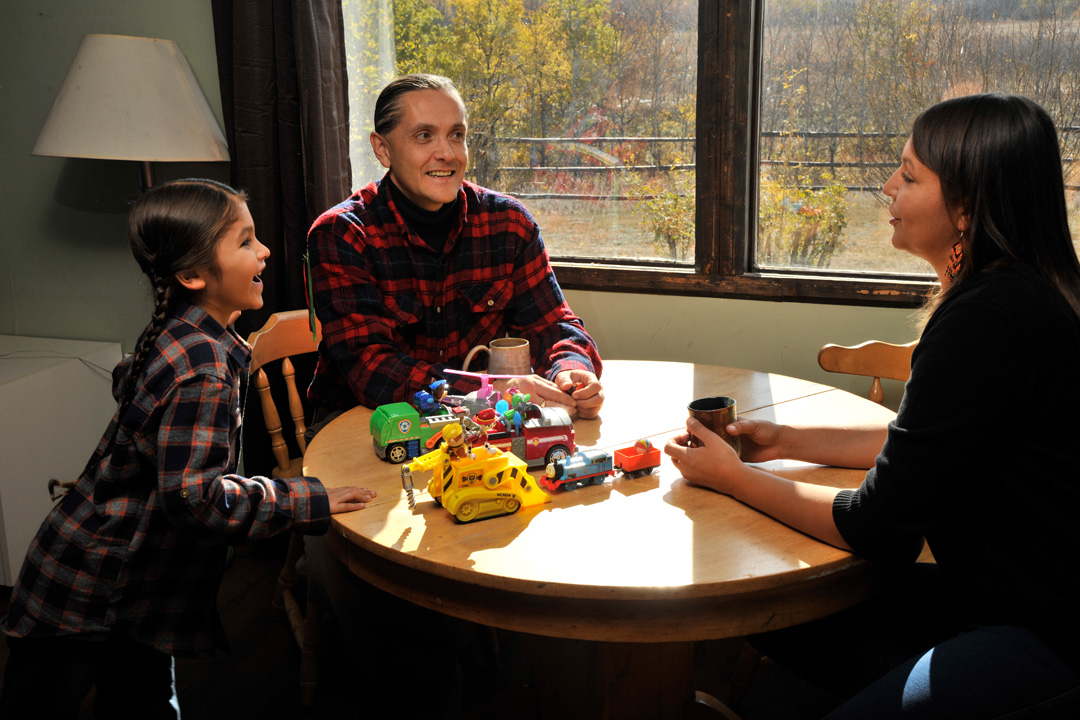
Brass enjoys some quality time with husband Phillip Brass and son, Forest in their Peepeekisis home. (Photo by Don Hall)
I’ve spent my life hearing that call. This deep longing to remember who I am is my spirit calling to me. It’s the spark, a fire lit within. Sometimes the blaze is strong and bright. Other times it’s an ember, a tiny point of light in the vast darkness. It never goes out. It’s the driving force behind everything I do. It guides me along a particular life path that’s been both a blessing and a burden.
I experience the deep fulfillment and joy of reconnecting to Indigenous ceremonies and teachings. I also engage with emotionally exhausting work that’s created the most anguish in my life; searching for a way to reconcile two completely different cultures inhabiting the same space, both figuratively and literally. My inner world and the outer world reflect the same struggle – Indigenous and non-Indigenous worldviews attempting, but failing, to live harmoniously. This dichotomy, and searching for a way to reconcile the two, has essentially become my life’s work, for better or for worse.
"I didn’t realize it at the time, but the pain I was experiencing was a very deep, profound grief over everything that has been taken from our people. I was grieving for something I never had the chance to have. But my spirit remembered and was crying out for me to recall, reconnect and reclaim our traditional ways of living."
This calling is what drove me to pursue a journalism career at 17. I believed if Canadians understood our shared history and Indigenous perspectives, we could create a stronger future. I had grand notions of building bridges between Indigenous and non-Indigenous people and healing this damaged relationship through storytelling.
My passion and purpose, my fire, propelled me forward. I completed the Indian Communication Arts program at the Saskatchewan Indian Federated College and graduated with distinction from the School of Journalism in 2002. I landed the internships of my choice and won competitive scholarships, including two major student awards from the Radio and Television News Directors Association. They are among the top national awards in the industry. I was offered jobs immediately upon graduation. The spark within me was ablaze. I was young, idealistic and ambitious.

Brass works on her writing at her home on Peepeekisis Cree Nation. (Photo by Don Hall)
Over the next decade, I built my career and landed my dream jobs. I was a TV and radio reporter for CBC Saskatchewan. I did corporate communications for the City of Regina and the Federation of Sovereign Indigenous Nations. I was recruited as editor of
Shout, a glossy, monthly magazine for Indigenous youth across the province. I landed my own provincial talk show on CJME NewsTalk Radio. I wrote a monthly column for the
Saskatoon StarPhoenix and
Regina Leader-Post. I was host of
The Afternoon Edition on CBC Radio in Saskatchewan. All of my dreams had come true.
Except they really hadn’t.
Behind my career success, I experienced incredible emotional and spiritual pain due to unresolved intergenerational trauma. The weight of my anguish was crushing me and nothing seemed to help. Deep down, I knew my healing would come from my culture and ceremony. I yearned and searched for my cultural teachings. I learned bits and pieces here and there but, without family connections to my culture, I hit a lot of dead ends.
I didn’t realize it at the time, but the pain I was experiencing was a very deep, profound grief over everything that has been taken from our people. I was grieving for something I never had the chance to have. But my spirit remembered and was crying out for me to recall, reconnect and reclaim our traditional ways of living.
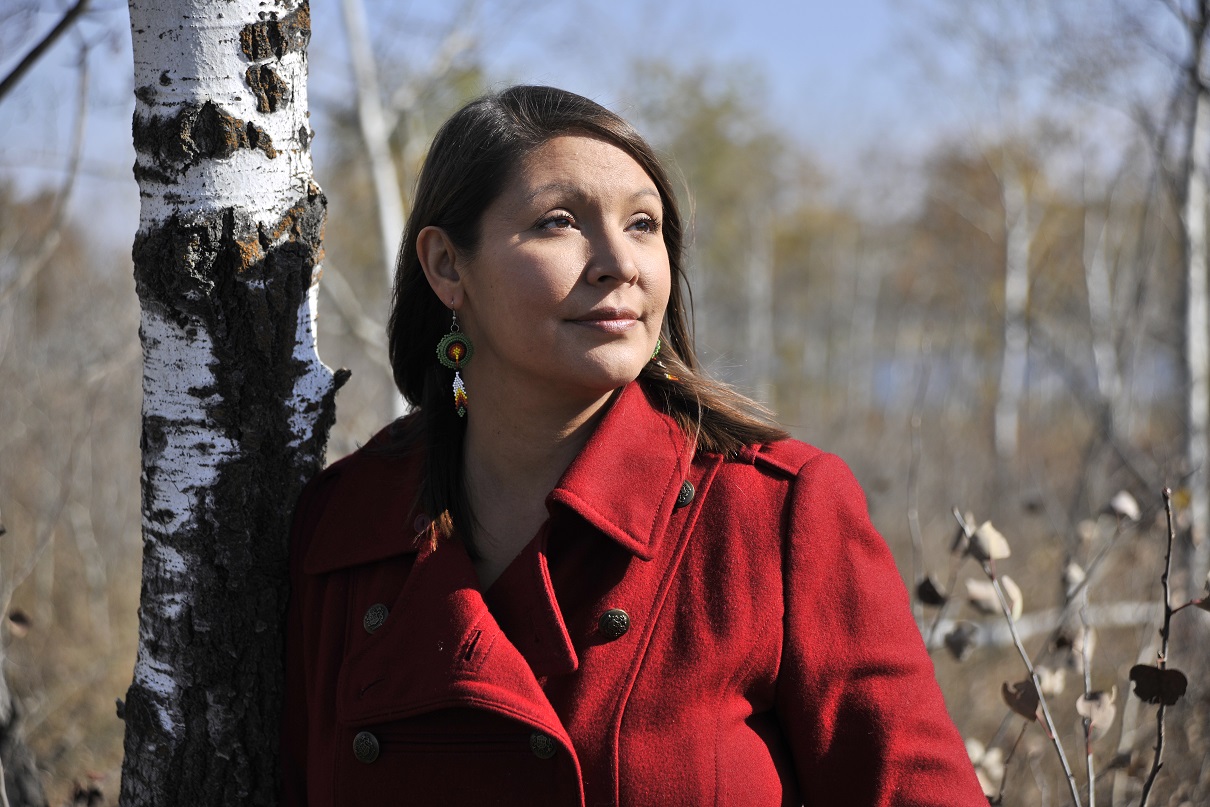
Brass was a rising star in the journalism field until she turned her back on her chosen career to focus on Indigenous food sovereignty, climate change, Indigenous health and wellness and personal healing and transformation. (Photo by Don Hall)
Some people say we lost our culture, language and way of life. My journalism career taught me the importance of language and word selection. We didn’t lose our culture as though we were careless. That’s like saying we lost our keys. Our entire way of life — everything — was maliciously stolen from us. It’s important to say that, to tell the truth. If the idea of reconciliation is to be a real possibility (and I’m not at all convinced that it is, at least not in my lifetime), we must start by telling the truth of what happened and continues to happen on these lands.
This desire to tell the truth and begin healing this relationship is what inspired me to pursue journalism over other professions. Throughout my career, I maintained a deep commitment to covering Indigenous stories in a fair and accurate manner and to covering all stories with integrity and excellence. I’d like to think I made a difference through my news stories, interviews and writing. I poured my heart and soul into this work to help build a stronger future for all of us.
"So just like that, I quit my career. My passion and purpose were gone. Without it, the work felt hollow and meaningless."
But one day, out of the blue, it all felt like a total waste of my time and energy. I was spending my life inside a newsroom feeding a never-ending news cycle instead of doing the real work of picking up the pieces of our culture that our parents, grandparents and great-grandparents left behind. Suddenly everything felt futile and silly. I couldn’t stand the newsroom, the on-air banter and five-minute interviews. Even more, I couldn’t stand having to continually educate my colleagues about Indigenous-Canadian facts and history, battling ridiculous stereotypes and reading racist comments on online news stories. I was completely done with it all.
So just like that, I quit my career. My passion and purpose were gone. Without it, the work felt hollow and meaningless. Not only was I done with journalism, I wanted nothing to do with building bridges between Indigenous and non-Indigenous people. I was done with that too. My flame had been snuffed out.
It’s taken me eight years to realize the fire is still there. An ember, burning steadily, guiding me and steering me in ways I didn’t understand or welcome at the time.
After leaving journalism, my husband and I moved to Peepeekisis Cree Nation. In the first year we spent a lot of time with wonderful Cree knowledge keepers attending ceremonies, picking medicines and learning teachings. Our son was born and we continued down this path, going to the lodges and learning and living by the teachings as best we could. We’re deeply committed to this way of life. Ceremonies and teachings set the foundation for everything we do.
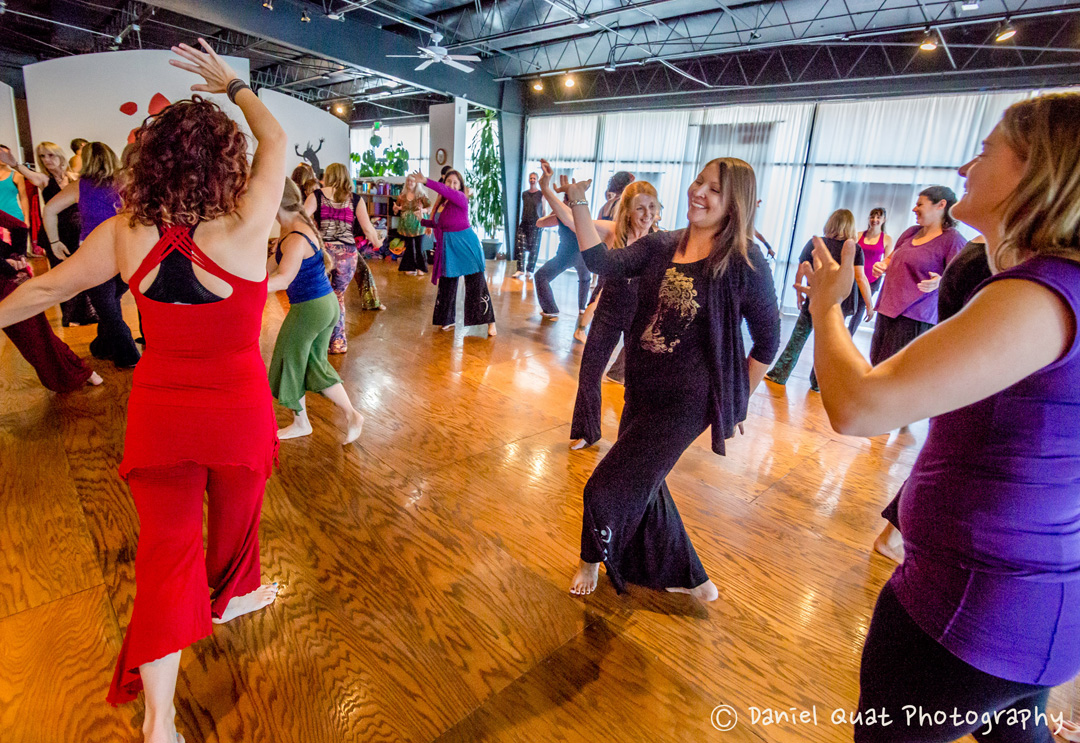
Brass (centre in purple) facilitates a session of JourneyDance, a therapeutic dance form that uses music, freestyle movement and imagery to release emotions and create healing. (Photo courtesy of Michelle Brass)
I also searched for a new career. I became an integrative nutrition health coach and took on some clients. I discovered JourneyDance, a therapeutic dance form that uses music, freestyle movement and imagery to release emotions and create healing in our lives. I completed three modules of intensive training to become a JourneyDance certified facilitator and began to lead classes and workshops. I also studied at the Martha Beck Institute for a year to become a life coach. These modalities, combined with Indigenous ceremonies as my foundation, started me on a path of deep healing. I wanted to share these tools with others on a similar path. Everything in my life was centred around holistic health, healing and living in a place of freedom and joy. I was excited to lead workshops and coaching programs to help people live lives full of purpose and meaning.
"It stoked the fire within and now it blazes red hot. My passion and purpose have returned. I stand, with my ancestors behind me, for the water, air, soil, animals, plants and our future with a fierce love and determination."
It was a wonderful period of transition, discovery and healing. Throughout this time, however, I couldn’t shake a sense of duty and responsibility to bring Indigenous and non-Indigenous people together. I tried repeatedly to let it go, but the idea wouldn’t let go of me. I didn’t want to work in the intersections of Indigenous and non-Indigenous anymore. But my lineage includes both the colonized and the colonizers, and so it seems the work I came here to do sits firmly within that realm.
It has become painfully clear to me that I can quit my career but I can’t quit my calling. The spark that drove me to succeed is still there, guiding me forward. It’s my ancestors calling me to do my part. As an Indigenous woman, I have a responsibility to my community, particularly to our children. We receive guidance in our lodges. We all have work to do. For me, that is accepting and honouring my identity and heritage by working with both Indigenous and non-Indigenous peoples to work out how we will share this space in a way that provides a good life for all.
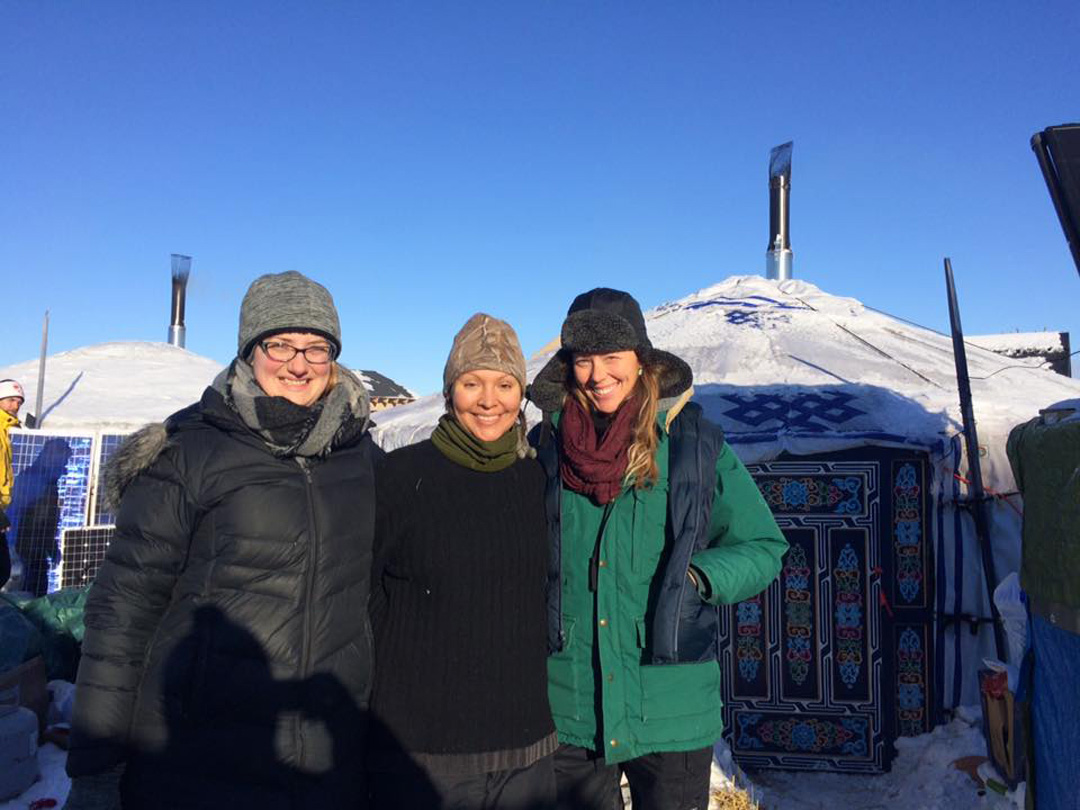
Brass with friends at Standing Rock Indian Reservation, site of the Dakota Access Pipeline protest. (Photo courtesy of Michelle Brass)
In December 2016, I went to Standing Rock for ten days to support our Lakota brothers and sisters protecting the water. I spent my time with the Indigenous midwives in the medic camp. We shared stories, songs and teachings with one another about the role of our women as we protect Mother Earth and live according to her natural laws. To say the experience was profound feels trite. It created a deep shift in me and brought everything in my life into sharp focus.
I left there with a renewed commitment to work for the Creator, to heed the guidance of the Grandmothers and Grandfathers (our spirit guides), to be in service to Mother Earth, women and future generations. It stoked the fire within and now it blazes red hot. My passion and purpose have returned. I stand, with my ancestors behind me, for the water, air, soil, animals, plants and our future with a fierce love and determination.
"My work is about developing my relationship with the land and understanding and respecting our natural laws. It’s about learning our languages, ceremonies, teachings and way of life. This is what will heal us. This is what will save us."
I’ve resisted for a very long time but I’ve finally found my way back to wanting to heal the relationship between Indigenous and non-Indigenous peoples. It’s different now. It’s evolved. Before, I focused on healing the past. Now, it’s about standing up for our future. We’ve been warned in our ceremonies about hard times coming. Climate change poses the greatest threat we’ve ever faced and will require extreme changes on a massive scale. We must work together. Traditional Indigenous knowledge is vital for the survival of our children and grandchildren. It always has been.
I no longer have any interest in trying to change colonial systems to improve the lives of Indigenous people. Instead, my focus is on strengthening our traditional knowledge systems and adhering to our ancient teachings. My work is about developing my relationship with the land and understanding and respecting our natural laws. It’s about learning our languages, ceremonies, teachings and way of life. This is what will heal us. This is what will save us.
For years, I’ve tried to walk in two worlds; to discover who I am and connect to my roots, while simultaneously achieving success in my career and western society. But I’ve come to realize we’re not meant to walk in two worlds. We’re meant to walk in one world. The real world. The world of grass and soil and land, the world of water and air and trees and plants. The world of the four-legged and the winged and water creatures. The world of relationships and kinship. The real, natural world where Mother Earth is calling for all of us to remember who we are and how to live with her and with one another.


[post_title] => Following the flame
[post_excerpt] => When she graduated from the University of Regina’s School of Journalism in 2002, Michelle Brass had the world by the tail. She was landing her dream jobs, including one at CBC Radio as the host of The Afternoon Edition. Then, just as her young career was skyrocketing, she gave it all up in search of a truer existence rooted in her Saulteaux heritage.
[post_status] => publish
[comment_status] => open
[ping_status] => open
[post_password] =>
[post_name] => 360-degrees-following-the-flame
[to_ping] =>
[pinged] =>
[post_modified] => 2018-12-12 10:35:20
[post_modified_gmt] => 2018-12-12 16:35:20
[post_content_filtered] =>
[post_parent] => 0
[guid] => https://www.degreesmagazine.ca/?p=2115
[menu_order] => 0
[post_type] => post
[post_mime_type] =>
[comment_count] => 0
[filter] => raw
)
WP_Post Object
(
[ID] => 2151
[post_author] => 5
[post_date] => 2018-11-02 09:09:26
[post_date_gmt] => 2018-11-02 15:09:26
[post_content] =>
Arrows drawn in coloured chalk adorn a sidewalk that winds past a teepee and between trees toward Luther College at the University of Regina. At the end of the chalk rainbow road is a message: Welcome to Camp fYrefly. We love you.
Inside, Jolie Brewer BEd’12 runs her hand through her short rainbow-coloured hair. She apologizes for her tears. Brewer often finds her work as Saskatchewan Camp fYrefly’s co-chair emotionally overwhelming. She didn’t expect today’s tears so early. She bobs a teabag up and down in a to-go cup as morning sounds echo down the hall. Groggy hellos blend with the scent of fresh coffee and hot omelettes. Most of the youth are already gathered at long tables in Thorn Hall, save for the late sleepers.
Camp fYrefly is a four-day annual summer retreat that alternates between Saskatoon and Regina. The camp welcomes teens and young adults who identify as questioning, gay, transgender, bisexual, intersex, two-spirit and allied. Campers are welcome to be themselves at Camp fYrefly. It’s often the first time they aren’t the minority. Those closest to the program say Camp fYrefly saves lives.
“They’re all broken in some way,” she says. “It’s heartbreaking, because they struggle to reach out for help.”
Brewer has been part of the camp for about seven years. Each year is different, but Brewer speaks of similarities in the rookie attendees: tiny creatures with no self-confidence. “They’re all broken in some way,” she says. “It’s heartbreaking because they struggle to reach out for help.”
Brewer’s voice breaks and she takes a deep breath, acknowledging Camp fYrefly is the first safe place many of the youth have ever been. But she marvels at some campers’ transformations. “By the last day of camp, those once scared little people realize how beautiful they are,” she says.
The camp has been built through the efforts of dozens of volunteers who have contributed thousands of behind-the-scenes hours to make each year possible — and better than the last.
There is a story of self-discovery behind every person who comes to the retreat, including staff and volunteers. Brewer found the camp not long after her husband Jett came out as transgender. The road to now was rocky for the pair. “I don’t know that our relationship would be as strong as it is today without camp. I know camp saves lives,” she reiterates. The couple celebrated 16 years together in 2018.
One-third of fYrefly campers identify as First Nations or Métis, with many coming from northern Indigenous communities such as La Ronge or La Loche. Saskatchewan Transportation Company once provided bus passes to youth in these communities, but the provincial government shut down the service in May 2017. The closure made it more difficult to attend, but it didn’t stop northern youth determined to take in the camp. For the past two years, a grandmother from northern Saskatchewan has driven four two-spirit youth — three from Cumberland House and one from Southend — to camp. That’s 650 kilometres, one way.

Darlene Lanceley, the Knowledge Keeper at camp, exits Luther College and strides to the camp teepee tucked on the grass. An Indigenous leader, most often an Elder, is always present at Saskatchewan’s Camp fYrefly to provide spiritual guidance, stories and healing.
Lanceley begins a smudge as the young adults head to rooms 211 and 215 for the sex ed and healthy relationships workshops. There are workshops focused on mental health and identity, but activities also include yoga, bead working, break-dancing, robotics, and
arts and crafts.
The campers break into small groups to debrief, but they aren’t the only ones who need to unwind. The leadership crew carries the weight of the campers’ burdens in addition to their own. But they know to lean on one another for support.
Brewer reaches out and raps the table twice with her knuckles. “With its 10th anniversary, it’s becoming a well-oiled machine,” she says.
The camp has been built through the efforts of dozens of volunteers who have contributed thousands of behind-the-scenes hours to make each year possible — and better than the last.
“It was exhilarating. It was as if we were breaking ground,” says professor emeritus James McNinch, recalling the camp’s establishment in Saskatchewan 10 years ago. McNinch was the dean of education at the University of Regina — the first dean who was openly gay.
McNinch takes a minute, pushing his dark glasses up the bridge of his nose before crossing his legs. He sets down his cup and rubs his collar bone. He remembers how safe spaces for gay and lesbian kids, let alone transgender, were near-absent in the province circa 2008.
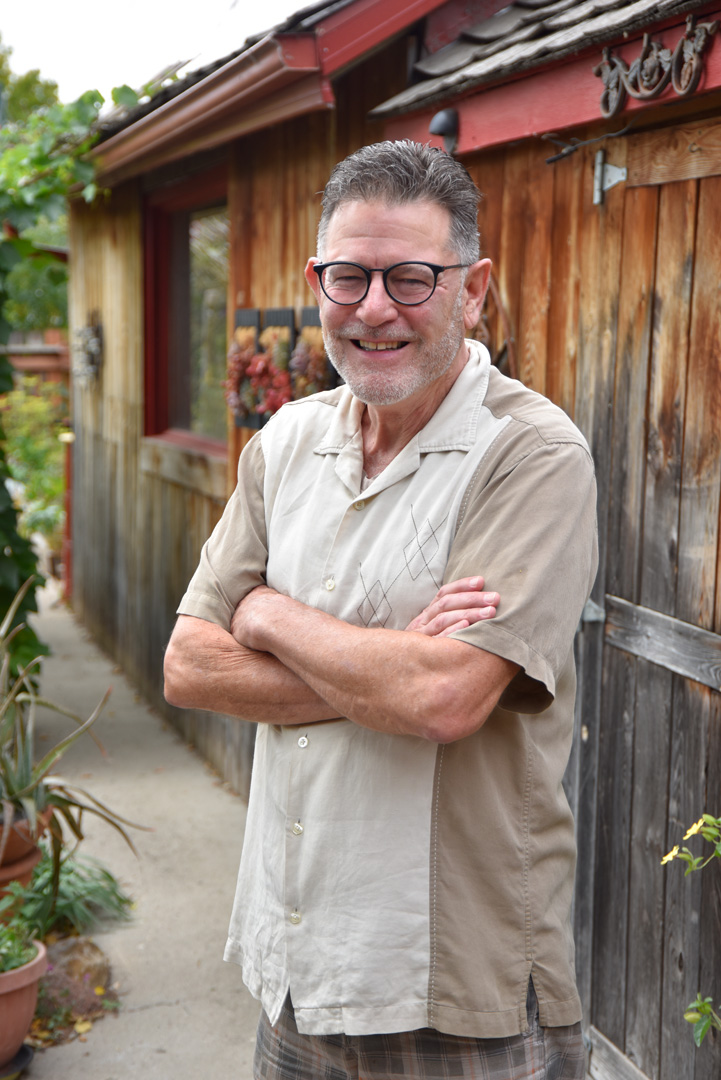
Professor emeritus of the U of R Faculty of Education James McNinch helped bring Camp fYrefly to Saskatchewan. (Photo by Trevor Hopkin)
Safe spaces are still hard to come by. Bullying is still present even within schools that have a GSA — or Gay-Straight Alliance, although the phrase Gender and Sexuality Alliance is gaining favour because it reflects a more inclusive perspective.
McNinch says the kids who aren’t supported, “for whom being queer is quite a challenge,” have the toughest battle.
McNinch led the way for the camp, using his position as dean to generate momentum. Camp fYrefly first began at the University of Alberta in 2004 under the leadership of Andre Grace and Kristopher Wells, who work in the University of Alberta’s Faculty of Education. It wasn’t long before they noticed youth coming from Saskatchewan. They approached McNinch to run a camp in Saskatchewan and he enthusiastically accepted.
McNinch brought the camp to life with help from Carla Blakely and Russell Mitchell-Walker, as well as Saskatoon co-chairs Anthony Bidulka and Herb McFaull, and support from the Faculty of Education, the University of Regina and the University of Saskatchewan. The first year, the camp was held at a private facility in Saskatoon and was a success. The location remains a secret for the sake of the organizers and sponsors.
Campers find strength in numbers and learn how to help others along the way. In Alberta, the retreat had always been held on campus but that didn’t seem feasible for Regina at the time.
“We couldn’t imagine that 10 years ago, the campus was a safe space,” McNinch says. “So fYrefly settled into the countryside.”
Food, craft supplies and AV equipment were trucked out to Lumsden Beach Camp, which is operated by the United Church. McNinch and his partner Michael Hamann rented a trailer so they could stay on site. The wooden cabins and rustic scenery were a change of pace from the neat, private rooms in Saskatoon. Hamann was one of the camp cooks.
“Very few understand what it’s like to feel marginalized as the only gay person in a small town or the only transgender person in your school,” he says.
McNinch admits it was exhausting to haul out supplies and prepare meals for 75 people for four days. But the natural beauty on the shores of Last Mountain Lake and the valley’s isolation fostered a special sense of freedom. McNinch recalls a moment from Lumsden when campers were transfixed by Indigenous artist-in-residence Adrian Stimson. They watched Stimson emerge from beneath a buffalo robe adorned in fishnet stockings, a priest’s collar and a crucifix. According to McNinch, at camp, truth and reconciliation work is underway to reverse systematic colonial repression of First Nations’ gender and sexuality.
Lumsden Beach Camp hosted fYrefly three times. By the time 2016 rolled around, camp co-ordinators felt the Regina campus would better suit their needs. Luther College was chosen, but the move was not without growing pains.
“They didn’t quite understand our need for seclusion,” McNinch says.
Residence renovations and summer courses were underway, University students were smoking, and the cafeteria was a madhouse as preteen science camp kids shared the dining room with the queer campers.
“It was quite different from fYrefly being out at Lumsden Beach Camp, where we were just there with the birds,” McNinch says.
Regina co-chair Michael White BEd’03, MEd’07, a registered psychologist and Saskatchewan’s Camp fYrefly counsellor for nine years, leads a workshop at Luther College.
(Photo by Rae Graham)
Saskatchewan fYrefly co-chair Michael White BEd’03, MEd’07 is a registered psychologist and has been Saskatchewan’s fYrefly counsellor for nine years. He recalls spending one and a half hours listening to an Indigenous camper who lived in northern Saskatchewan. The transgender teen detailed years of traumatic abuse and neglect experienced while lost within the foster care system.
“Very few understand what it’s like to feel marginalized as the only gay person in a small town or the only transgender person in your school,” he says. White grew up in Stephenville, Newfoundland and Labradour, and didn’t come out until later in life. “You don’t have to hide any aspect of your identity at camp.”
The answer was as obvious as it was terrifying. Penner cried as he pulled out his phone and messaged his partner: “I think I’m a boy.” He sighed at the response: “That’s okay.”
Moe Penner, 18, settles into the couch at Luther College. Fidgeting with his sleeves, the First Nations University of Canada Indigenous Social Work student recounts being 15, alone in the dark and in silence as he penned the pros and cons of coming out.
The answer was as obvious as it was terrifying. Penner cried as he pulled out his phone and messaged his partner: “I think I’m a boy.” He sighed with relief at the response: “That’s okay.”
Penner, assigned female at birth, questioned his identity for years. He spent hours in online forums and watching YouTubers. Eventually, he realized it was the gender that was wrong. His partner helped him come out to his mom, who was more accepting than Penner’s father, who said, “She’s 16. She can’t make her own choices.”
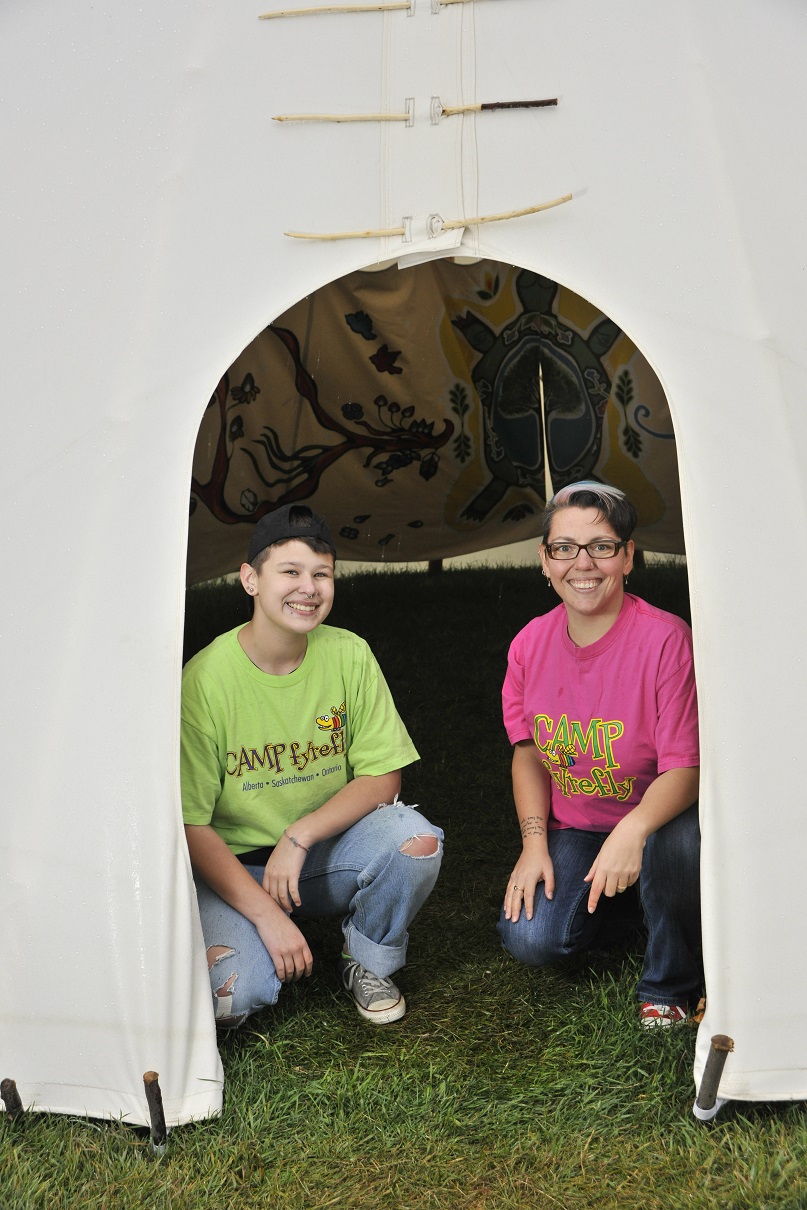
Saskatchewan Camp fYrefly’s co-chair Jolie Brewer BEd’12 (right) and Moe Penner, an Indigenous Social Work student at First Nations University of Canada and a youth leader at this year’s camp. (Photo by Don Hall)
The anxiety from the lack of acceptance persisted and Penner spent days trembling and sweating while attending high school at Regina’s Winston Knoll Collegiate. Suicidal
thoughts would bubble to the surface of his mind.
Penner’s mom took him to a doctor, which helped, but still the mental anguish continued. He found a unique reprieve in the summer of 2016, when his mom dropped him off at Camp fYrefly for the first time. While the first day is always the scariest, it’s not long before campers fall in love with camp.
Penner didn’t hesitate when White asked if he would return in 2018 as a youth leader. “I was ecstatic. I was so excited. Somebody sees some potential in me,” he beams.
Now the new campers are windows to Penner’s past. Penner wants to tell them: “I’ve been through this. It’s okay. It will get better.”
Camp fYrefly is celebrated as Saskatchewan’s first gay camp. The demographic has shifted since it first started, with more youth identifying as trans, two-spirit or gender-fluid. The campers are also getting younger.
“They’re so much different than I was,” says McNinch, who graduated from high school in 1965, a time when “compulsory heterosexuality” was an expected norm.
In 1967, Justice Minister Pierre Trudeau pushed for changes to Canada’s Criminal Code; homosexuality was decriminalized in 1969 as part of those amendments. McNinch didn’t come out until much later in his life, when he moved to Saskatoon with his wife Sharon. A friend suggested McNinch go to a gay club, where McNinch had an epiphany. He moved to Regina after he and his wife separated.
“I see these kids who, like me many, many years ago, had to build new relationships and you can’t do that all alone.”
McNinch says the kids who aren’t supported, “for whom being queer is quite a challenge,” have the toughest battle.
Oh my god, McNinch thought, I’m worried about building resiliency for personal identity, when so many young people know so little about their bodies.
Gender and sexually diverse youth are at greater risk of depression, excessive drug use, suicide, a life on the streets or family estrangement, according to Canadian surveys, studies and academic literature. The risk intensifies in rural and remote communities that have fewer resources. Thankfully, youth emerge from camp with self-confidence and a sense of pride. Their peers become like family. But when they return home to their families, communities and schools, they are most often treated as before.
McNinch has heard tired lines like “He’s come back from camp and he’s more gay than ever.” That’s why fYrefly brings parents and guardians to camp for their own workshop. It’s held on the last day of camp, before they see their kids. Parents meet other parents. They talk about camp, as well as how to handle the future. McNinch has seen a dramatic increase in supportive parents, grandparents and caregivers. With each new set of campers, the session remains an integral part of helping expand the safe space beyond the four days at camp.
McNinch welcomed the 2018 campers at registration. He was there for the parent session and clean-up on the last day. Once again, he saw the evolution of shy campers who hugged and danced their way out the door.
His eyebrows rise as he notes the significant societal change of sexual diversity within his lifetime: “going from completely illegal, illicit and immoral to being legal and celebrated.”
“This idea of light and the light of who you are — that’s fYrefly.” says McNinch. “Hide it under a bushel,” he sings softly. “No. I’m going to let it shine.”
The overarching goal was always to reach a time when camp was no longer necessary. McNinch wonders if that day will ever come. He realizes newcomers are arriving from countries where open gender and sexual diversity is punishable or taboo. He remembers a teen’s question at a Saskatoon workshop: “Can you get pregnant from anal sex?”
Oh my god, McNinch thought, I’m worried about building resiliency for personal identity, when so many young people know so little about their bodies.
McNinch says that camp often brings up examples of why education is needed outside of camp. It’s why fYrefly in Schools is so dear to McNinch’s heart. It’s a practical expansion of camp that carries the fYrefly mandate into the community. The fYrefly in Schools co-ordinators work with school divisions and offer age-appropriate lessons on gender identity and sexual diversity within the Saskatchewan curriculum. They give presentations for students and staff on a wide range of topics that detail definitions, potential outcomes of homophobia or transphobia, and what life is like for queer people. They teach people how to be allies.
It was near the time of McNinch’s retirement when he began to relinquish some of his responsibilities with the camp. He muses about the last 10 years, and the meaning of fYrefly and its curious logo. People don’t always recognize the grinning, bug-eyed, insect as a fYrefly. The oft-misunderstood creature represents a being that creates its own energy and light.
McNinch remembers how Hamann, who was raised in a Lutheran Church, often talks about songs and verses of the Bible.
“This idea of light and the light of who you are — that’s fYrefly.” says McNinch. “Hide it under a bushel,” he sings softly. “No. I’m going to let it shine.”
[post_title] => Let it shine
[post_excerpt] => Camp fYrefly is an annual summer retreat for gender and sexually diverse youth. The camp, which alternates between Regina and Saskatoon, celebrated its tenth anniversary in early August. For all those associated with the camp, that’s a decade of bringing together young people who are often struggling with their sense of self and a decade of saving lives.
[post_status] => publish
[comment_status] => open
[ping_status] => open
[post_password] =>
[post_name] => let-it-shine
[to_ping] =>
[pinged] =>
[post_modified] => 2018-11-16 11:11:02
[post_modified_gmt] => 2018-11-16 17:11:02
[post_content_filtered] =>
[post_parent] => 0
[guid] => https://www.degreesmagazine.ca/?p=2151
[menu_order] => 0
[post_type] => post
[post_mime_type] =>
[comment_count] => 0
[filter] => raw
)
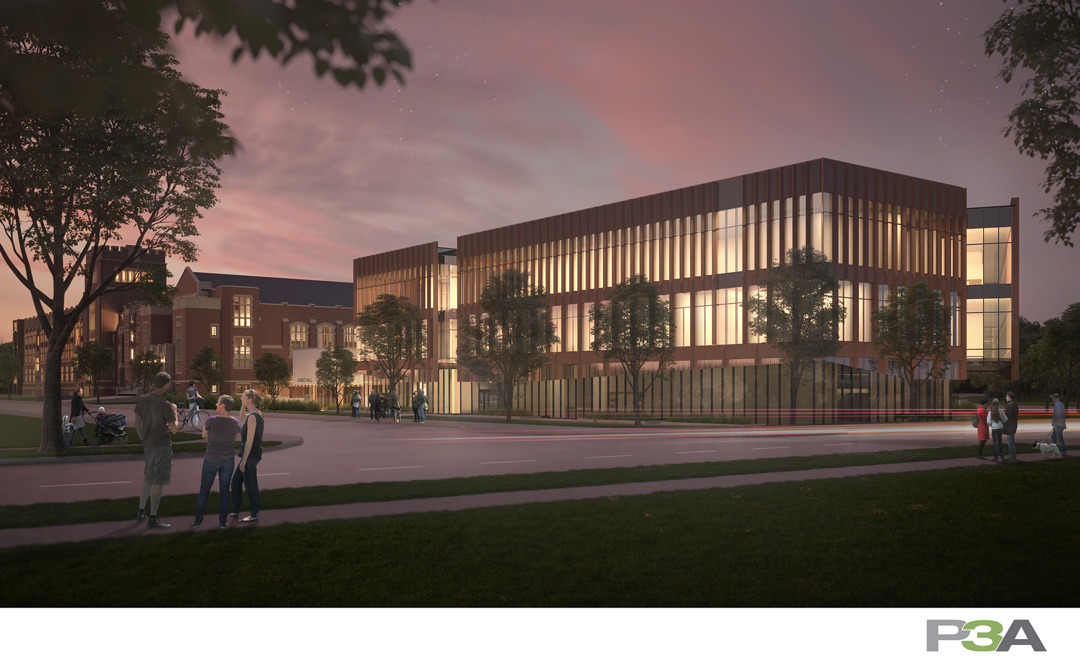
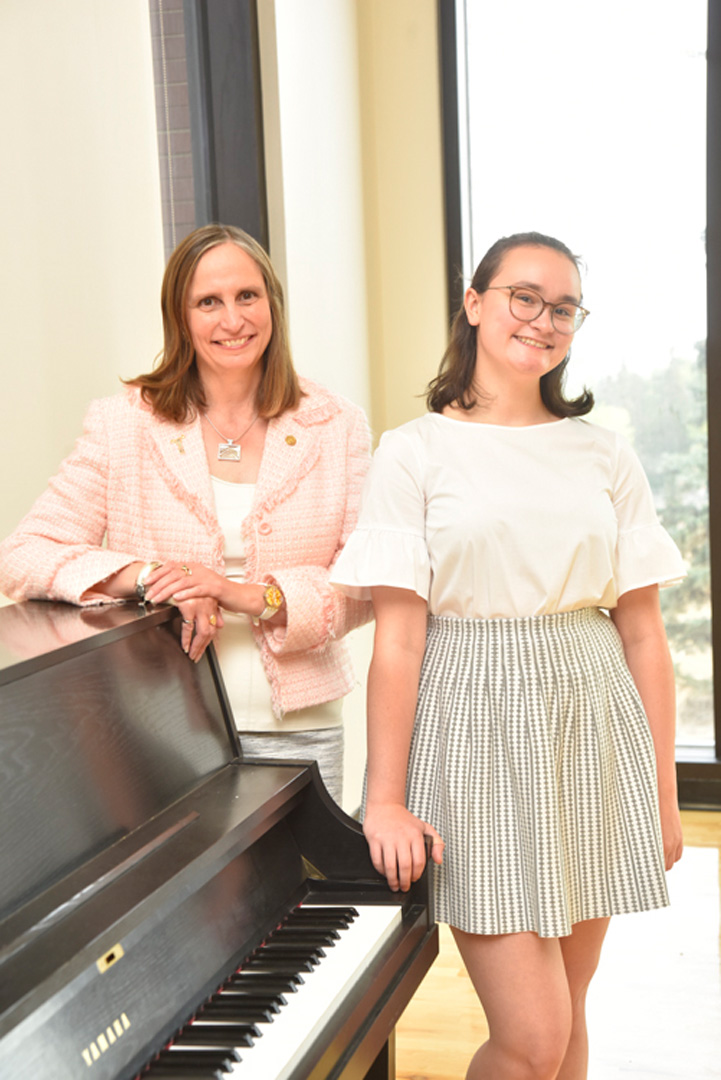
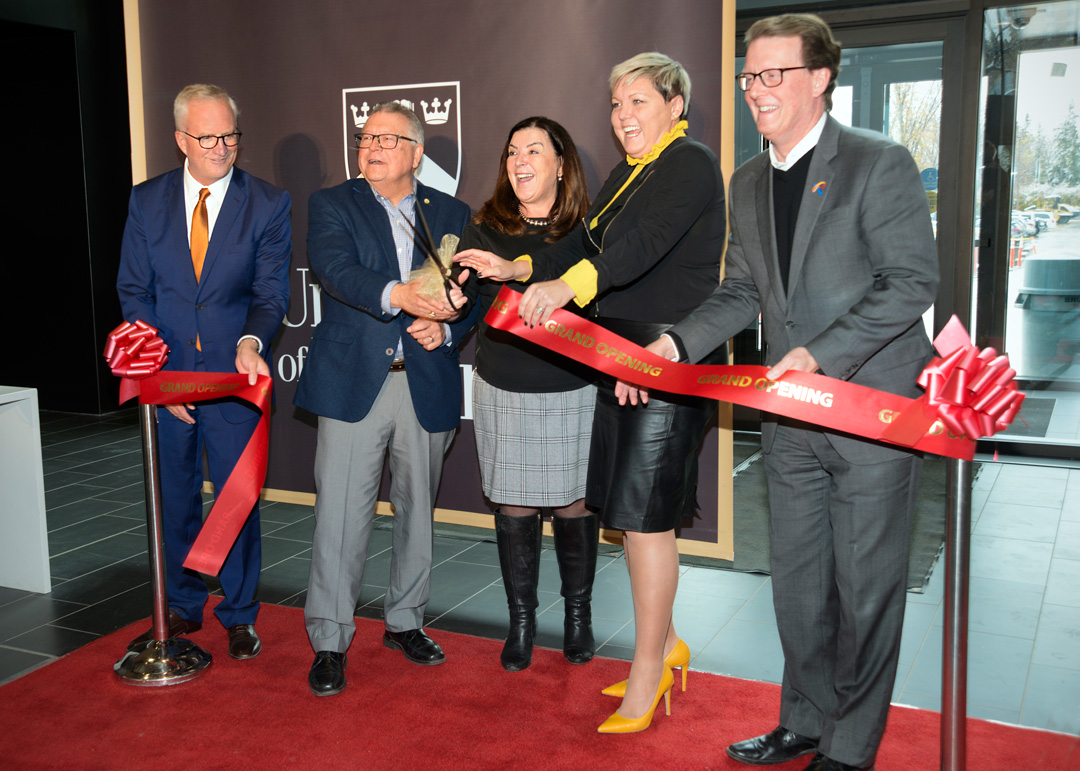
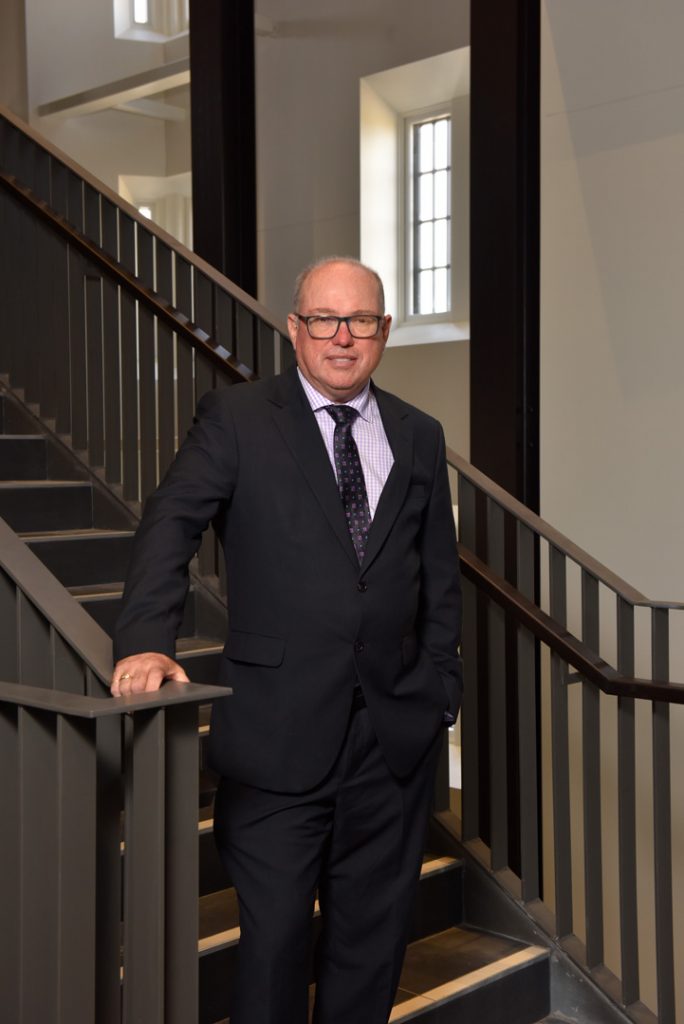
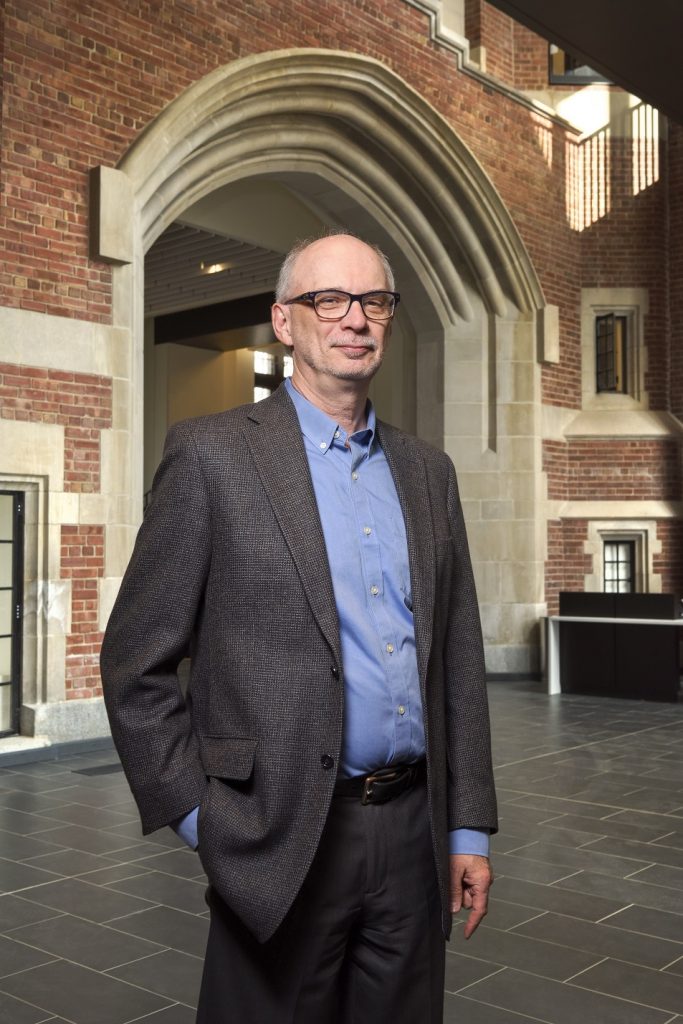

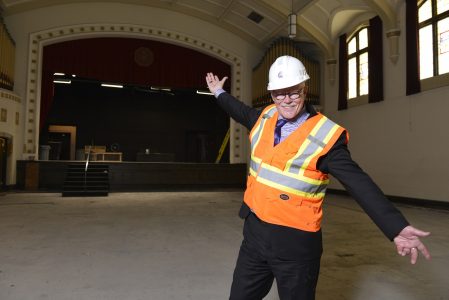

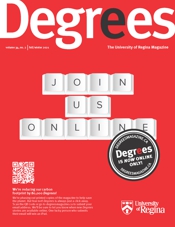

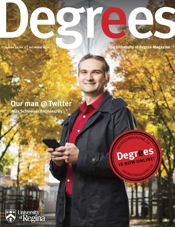


 Brass enjoys some quality time with husband Phillip Brass and son, Forest in their Peepeekisis home. (Photo by Don Hall)
I’ve spent my life hearing that call. This deep longing to remember who I am is my spirit calling to me. It’s the spark, a fire lit within. Sometimes the blaze is strong and bright. Other times it’s an ember, a tiny point of light in the vast darkness. It never goes out. It’s the driving force behind everything I do. It guides me along a particular life path that’s been both a blessing and a burden.
I experience the deep fulfillment and joy of reconnecting to Indigenous ceremonies and teachings. I also engage with emotionally exhausting work that’s created the most anguish in my life; searching for a way to reconcile two completely different cultures inhabiting the same space, both figuratively and literally. My inner world and the outer world reflect the same struggle – Indigenous and non-Indigenous worldviews attempting, but failing, to live harmoniously. This dichotomy, and searching for a way to reconcile the two, has essentially become my life’s work, for better or for worse.
Brass enjoys some quality time with husband Phillip Brass and son, Forest in their Peepeekisis home. (Photo by Don Hall)
I’ve spent my life hearing that call. This deep longing to remember who I am is my spirit calling to me. It’s the spark, a fire lit within. Sometimes the blaze is strong and bright. Other times it’s an ember, a tiny point of light in the vast darkness. It never goes out. It’s the driving force behind everything I do. It guides me along a particular life path that’s been both a blessing and a burden.
I experience the deep fulfillment and joy of reconnecting to Indigenous ceremonies and teachings. I also engage with emotionally exhausting work that’s created the most anguish in my life; searching for a way to reconcile two completely different cultures inhabiting the same space, both figuratively and literally. My inner world and the outer world reflect the same struggle – Indigenous and non-Indigenous worldviews attempting, but failing, to live harmoniously. This dichotomy, and searching for a way to reconcile the two, has essentially become my life’s work, for better or for worse.
 Brass works on her writing at her home on Peepeekisis Cree Nation. (Photo by Don Hall)
Over the next decade, I built my career and landed my dream jobs. I was a TV and radio reporter for CBC Saskatchewan. I did corporate communications for the City of Regina and the Federation of Sovereign Indigenous Nations. I was recruited as editor of Shout, a glossy, monthly magazine for Indigenous youth across the province. I landed my own provincial talk show on CJME NewsTalk Radio. I wrote a monthly column for the Saskatoon StarPhoenix and Regina Leader-Post. I was host of The Afternoon Edition on CBC Radio in Saskatchewan. All of my dreams had come true.
Except they really hadn’t.
Behind my career success, I experienced incredible emotional and spiritual pain due to unresolved intergenerational trauma. The weight of my anguish was crushing me and nothing seemed to help. Deep down, I knew my healing would come from my culture and ceremony. I yearned and searched for my cultural teachings. I learned bits and pieces here and there but, without family connections to my culture, I hit a lot of dead ends.
I didn’t realize it at the time, but the pain I was experiencing was a very deep, profound grief over everything that has been taken from our people. I was grieving for something I never had the chance to have. But my spirit remembered and was crying out for me to recall, reconnect and reclaim our traditional ways of living.
Brass works on her writing at her home on Peepeekisis Cree Nation. (Photo by Don Hall)
Over the next decade, I built my career and landed my dream jobs. I was a TV and radio reporter for CBC Saskatchewan. I did corporate communications for the City of Regina and the Federation of Sovereign Indigenous Nations. I was recruited as editor of Shout, a glossy, monthly magazine for Indigenous youth across the province. I landed my own provincial talk show on CJME NewsTalk Radio. I wrote a monthly column for the Saskatoon StarPhoenix and Regina Leader-Post. I was host of The Afternoon Edition on CBC Radio in Saskatchewan. All of my dreams had come true.
Except they really hadn’t.
Behind my career success, I experienced incredible emotional and spiritual pain due to unresolved intergenerational trauma. The weight of my anguish was crushing me and nothing seemed to help. Deep down, I knew my healing would come from my culture and ceremony. I yearned and searched for my cultural teachings. I learned bits and pieces here and there but, without family connections to my culture, I hit a lot of dead ends.
I didn’t realize it at the time, but the pain I was experiencing was a very deep, profound grief over everything that has been taken from our people. I was grieving for something I never had the chance to have. But my spirit remembered and was crying out for me to recall, reconnect and reclaim our traditional ways of living.
 Brass was a rising star in the journalism field until she turned her back on her chosen career to focus on Indigenous food sovereignty, climate change, Indigenous health and wellness and personal healing and transformation. (Photo by Don Hall)
Some people say we lost our culture, language and way of life. My journalism career taught me the importance of language and word selection. We didn’t lose our culture as though we were careless. That’s like saying we lost our keys. Our entire way of life — everything — was maliciously stolen from us. It’s important to say that, to tell the truth. If the idea of reconciliation is to be a real possibility (and I’m not at all convinced that it is, at least not in my lifetime), we must start by telling the truth of what happened and continues to happen on these lands.
This desire to tell the truth and begin healing this relationship is what inspired me to pursue journalism over other professions. Throughout my career, I maintained a deep commitment to covering Indigenous stories in a fair and accurate manner and to covering all stories with integrity and excellence. I’d like to think I made a difference through my news stories, interviews and writing. I poured my heart and soul into this work to help build a stronger future for all of us.
Brass was a rising star in the journalism field until she turned her back on her chosen career to focus on Indigenous food sovereignty, climate change, Indigenous health and wellness and personal healing and transformation. (Photo by Don Hall)
Some people say we lost our culture, language and way of life. My journalism career taught me the importance of language and word selection. We didn’t lose our culture as though we were careless. That’s like saying we lost our keys. Our entire way of life — everything — was maliciously stolen from us. It’s important to say that, to tell the truth. If the idea of reconciliation is to be a real possibility (and I’m not at all convinced that it is, at least not in my lifetime), we must start by telling the truth of what happened and continues to happen on these lands.
This desire to tell the truth and begin healing this relationship is what inspired me to pursue journalism over other professions. Throughout my career, I maintained a deep commitment to covering Indigenous stories in a fair and accurate manner and to covering all stories with integrity and excellence. I’d like to think I made a difference through my news stories, interviews and writing. I poured my heart and soul into this work to help build a stronger future for all of us.
 Brass (centre in purple) facilitates a session of JourneyDance, a therapeutic dance form that uses music, freestyle movement and imagery to release emotions and create healing. (Photo courtesy of Michelle Brass)
I also searched for a new career. I became an integrative nutrition health coach and took on some clients. I discovered JourneyDance, a therapeutic dance form that uses music, freestyle movement and imagery to release emotions and create healing in our lives. I completed three modules of intensive training to become a JourneyDance certified facilitator and began to lead classes and workshops. I also studied at the Martha Beck Institute for a year to become a life coach. These modalities, combined with Indigenous ceremonies as my foundation, started me on a path of deep healing. I wanted to share these tools with others on a similar path. Everything in my life was centred around holistic health, healing and living in a place of freedom and joy. I was excited to lead workshops and coaching programs to help people live lives full of purpose and meaning.
Brass (centre in purple) facilitates a session of JourneyDance, a therapeutic dance form that uses music, freestyle movement and imagery to release emotions and create healing. (Photo courtesy of Michelle Brass)
I also searched for a new career. I became an integrative nutrition health coach and took on some clients. I discovered JourneyDance, a therapeutic dance form that uses music, freestyle movement and imagery to release emotions and create healing in our lives. I completed three modules of intensive training to become a JourneyDance certified facilitator and began to lead classes and workshops. I also studied at the Martha Beck Institute for a year to become a life coach. These modalities, combined with Indigenous ceremonies as my foundation, started me on a path of deep healing. I wanted to share these tools with others on a similar path. Everything in my life was centred around holistic health, healing and living in a place of freedom and joy. I was excited to lead workshops and coaching programs to help people live lives full of purpose and meaning.
 Brass with friends at Standing Rock Indian Reservation, site of the Dakota Access Pipeline protest. (Photo courtesy of Michelle Brass)
In December 2016, I went to Standing Rock for ten days to support our Lakota brothers and sisters protecting the water. I spent my time with the Indigenous midwives in the medic camp. We shared stories, songs and teachings with one another about the role of our women as we protect Mother Earth and live according to her natural laws. To say the experience was profound feels trite. It created a deep shift in me and brought everything in my life into sharp focus.
I left there with a renewed commitment to work for the Creator, to heed the guidance of the Grandmothers and Grandfathers (our spirit guides), to be in service to Mother Earth, women and future generations. It stoked the fire within and now it blazes red hot. My passion and purpose have returned. I stand, with my ancestors behind me, for the water, air, soil, animals, plants and our future with a fierce love and determination.
Brass with friends at Standing Rock Indian Reservation, site of the Dakota Access Pipeline protest. (Photo courtesy of Michelle Brass)
In December 2016, I went to Standing Rock for ten days to support our Lakota brothers and sisters protecting the water. I spent my time with the Indigenous midwives in the medic camp. We shared stories, songs and teachings with one another about the role of our women as we protect Mother Earth and live according to her natural laws. To say the experience was profound feels trite. It created a deep shift in me and brought everything in my life into sharp focus.
I left there with a renewed commitment to work for the Creator, to heed the guidance of the Grandmothers and Grandfathers (our spirit guides), to be in service to Mother Earth, women and future generations. It stoked the fire within and now it blazes red hot. My passion and purpose have returned. I stand, with my ancestors behind me, for the water, air, soil, animals, plants and our future with a fierce love and determination.

 Professor emeritus of the U of R Faculty of Education James McNinch helped bring Camp fYrefly to Saskatchewan. (Photo by Trevor Hopkin)
Professor emeritus of the U of R Faculty of Education James McNinch helped bring Camp fYrefly to Saskatchewan. (Photo by Trevor Hopkin)
 Saskatchewan Camp fYrefly’s co-chair Jolie Brewer BEd’12 (right) and Moe Penner, an Indigenous Social Work student at First Nations University of Canada and a youth leader at this year’s camp. (Photo by Don Hall)
Saskatchewan Camp fYrefly’s co-chair Jolie Brewer BEd’12 (right) and Moe Penner, an Indigenous Social Work student at First Nations University of Canada and a youth leader at this year’s camp. (Photo by Don Hall)